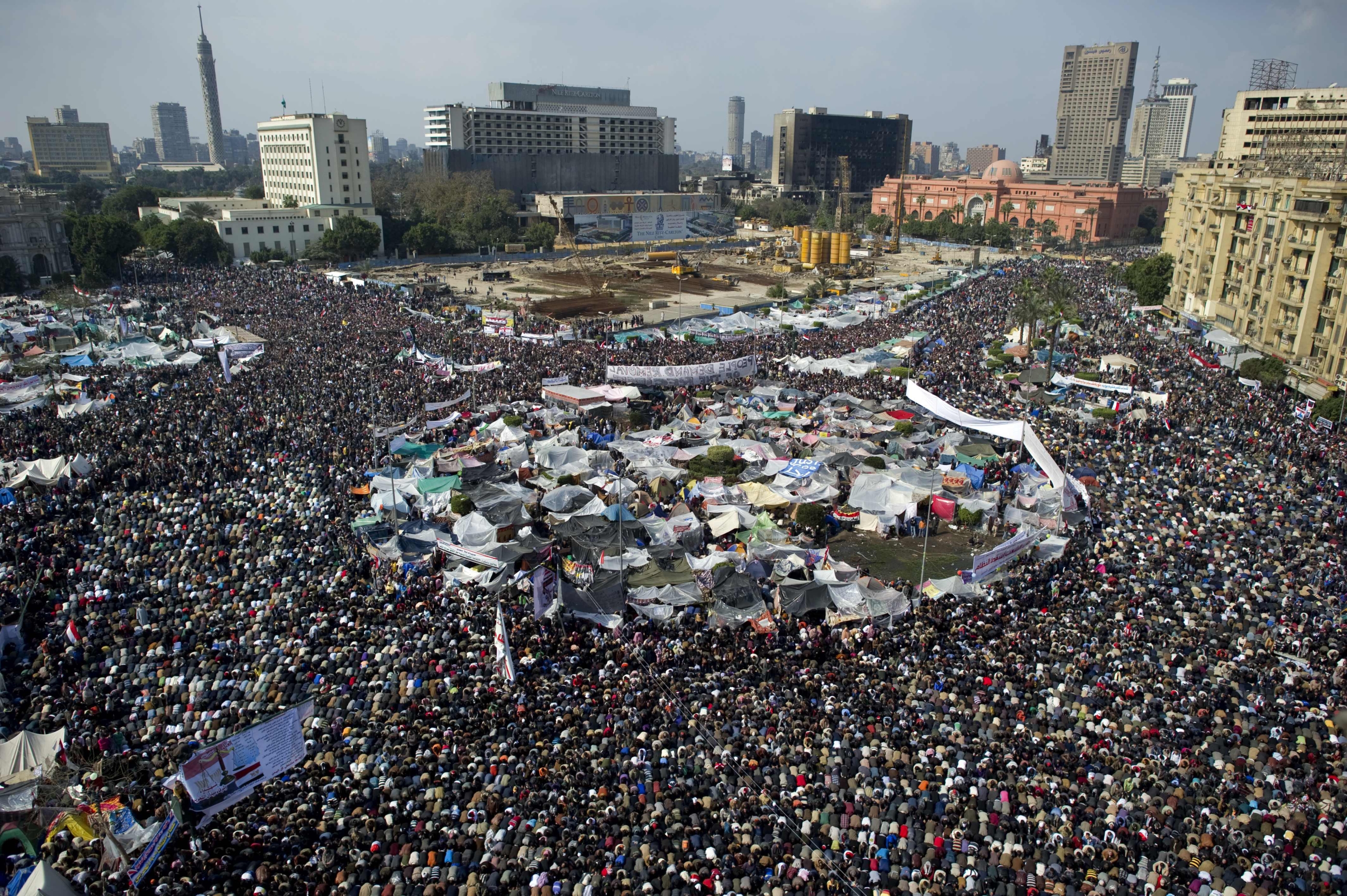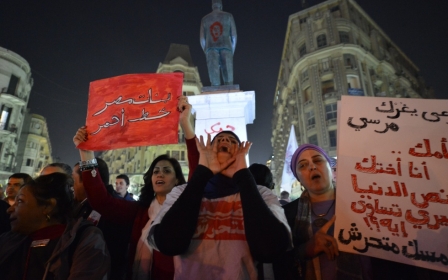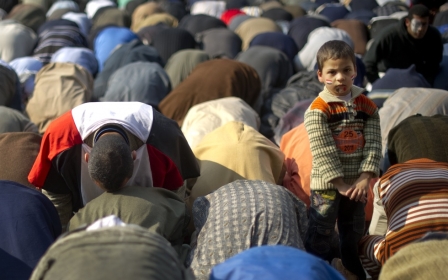Barricading the revolution: when city planning suppresses the people

CAIRO: The 18 days of demonstrations in Tahrir Square in 2011 - where huge crowds called for the toppling of the Mubarak regime - marked the gradual opening of the public sphere in Egypt. Dormant public spaces were transformed into sites of protests, with Tahrir as both epicenter and symbol of freedom of expression.
“People felt they had gained ownership of public space,” said Hajer Awatta, a researcher at Taqween, an urban development research centre in Cairo. “No one really feared the police anymore.”
In the years that have followed the revolution, Cairo’s streets have undergone a series of reconfigurations. In order to impede clashes and isolate important centres of power, successive authorities have constructed concrete walls across certain streets; in other cases, roads have been closed, or gates constructed. The city’s urban landscape is in a constant flux as once open sites have been segmented. Reinforced by a series of laws to clamp down on oppositional voices, these structures serve as physical reminders of the demolition of the open dissent that briefly emerged. “Now,” said Attawa, “the increasing presence of police, military police, and army in front of the population strips away their sense of ownership - especially with Tahrir.”
The military regime has re-appropriated sites of protest and public spaces in the city, altering the relationship between the state and citizens, as well as the population’s relationship to the city itself. Blockades and a stronger presence of security forces have reinforced the de-politicisation of the city that once erupted with defiance.
Seizing uprisings and spaces
On 30 June 2013, millions of Egyptians poured into the streets to demand the fall of the then President Morsi, with the military quick to offer its backing. This eventually led to the military coup on 3 July. Although there was mass mobilisation on the streets, not all the protesters that called for Morsi’s removal saw the military’s takeover as a legitimate or positive step.
“During a demonstration, a volume of space is filled, and the space is a sort of proof of the drive behind the demonstration,” said May al-Ibrashy, founder of Megawra, a hub for young architects in Cairo. “The military understood that they too, could do that by manipulating the masses and filling up space, and creating the illusion of populism,” she explained. “The ‘filling of space’ then became meaningless.”
Fenced out of the city
Following their takeover, the military has implemented various laws that stifle civil society. The protest law, the outlawing of the Muslim Brotherhood, and amendments made to crackdown on civil society have all served to quell legal dissent in the country. But there have been more subtle forms of control, too. The military’s takeover was also followed by the dismemberment of public spaces to ensure the state’s authority. Moving through the city, the urban reconfiguration is indicative of one’s limitations as a citizen – the city’s walls, gates and barbed wire, are concrete manifestations of a decrease in freedom of expression.
Although barriers have been constant constituents in the city’s urban landscape, particularly since 2011, what has largely shifted is how normal they now appear, and how widely accepted they seem to be. “[The barriers] used to be temporary – [erected] before or after a protest, or for a specific reason – now they are fixed,” said Al-Ibrashy. “Barriers are now there in lieu of actual activity.”
“Before, there were walls along Kasr al-Aini [a road leading into Tahrir] and that had become normalised at one point. So now that there are gates, it’s not seen as a shock,” said Awatta.
Both Awatta and al-Ibrashy noted the regularity of roadblocks, not only around Tahrir on politically charged days, but throughout the city on a daily basis. “Now even the closing of major streets has become common,” said al-Ibrashy.
In August of this year, the state forced street vendors to relocate from Talaat Harb, a busy shopping district downtown, to the Turgoman parking complex, a less frequented area 15 minutes away. For weeks, the space for vendor stalls was replaced with police vans and police in full body armour, lining the street, and a number of tanks were parked in Talaat Harb square. Despite the seemingly onerous obstacles on the road, people continued to go on with their daily business. Talaat Harb remained packed with promenading shoppers, crowds outside of cinemas, and queues at ice cream parlours.
According to Awatta, this illustrates how normal the state’s encroachment on public space and its use of intimidation now appear to the city’s citizens. “[The military] has created lower expectations for people’s rights,” said Awatta.
However, even if the population has become accustomed to barriers, al-Ibrashy says, they represent “physical triggers of fear” and the notion that citizens are under a constant threat. “If you continue to negotiate a city that’s a fortress, in the back of your mind you always have the idea that ‘something’ is going to happen”, she explained.
The relationship between state and citizens
The state has thus created a dynamic whereby the public is relegated to both live under palpable observation from police and military forces, as well as accept indirect censorship through the symbolic severing of access to public arenas. There has thus been a visual transfer of “ownership” of public spaces from the hands of the citizens, back into those of the regime.
Bolstered by its narrative to quash terrorism and its definitive discourse between the “good citizen” and the “traitor,” the state has persuaded the population that support for the regime is the only way to attain stability, and more importantly, is the only way forward for Egypt. “What has mainly changed [over the past three years] is people’s entitlement to demand for their rights has been removed,” said Awatta. “If they do, they are accused of being ‘selfish’”.
According to Al-Ibrashy, the barriers throughout the city are a constant reminder of the power relations between the state and its inhabitants. “It’s as if they are saying, ‘we have control over how you move’. This contempt for the citizen has been very typical”, said al-Ibrashy.
Al-Ibrashy attributes the use of intimidation by the state as a reaction to its own fears. “The concrete blocks [used for walls] are the physical manifestation of how the state fears the people.” Moreover, the regime is careful to negotiate between their power and control, while also seeming to remain on the “same side” as the public. “The regime is scared to say that the revolution shouldn’t have happened and that Tahrir shouldn’t be used for protests,” said al-Ibrashy. “They don’t want to cause outright disenchantment”.
The de-politicization of Downtown
Downtown Cairo is the political centre of all of Egypt. In 2007, the “Cairo 2050 Plan” was laid out - a proposal that would re-conceive downtown as a financial, commercial, and cultural hub, while pushing residential areas outwards into the desert, in order to relieve the urban centre of its high density.
For years, there has also been a proposal to relocate the capital centre 60 km down the Suez road. In July of this year, Prime Minister, Ibrahim Mahleb re-tabled the discussion, citing the relocation of ministries and administrative buildings as a means to decongest traffic and reduce crowding in the city.
According to Awatta, both proposals would detach citizens from their relationship to the city centre. Cairo 2050, for its part, would cater to a “certain type of resident,” and would centre around finance and tourism. The relocation of government buildings, meanwhile, would be a form of de-politicisation: “Cairo had gained a sense of political power [during 2011]. But when you remove important buildings, it loses that power,” said Awatta.
According to Awatta, the relocation of the “capital” would alleviate the city of its political weight, and would further disintegrate the momentum and morale of those in opposition to the state. “The state’s aim is not just to clean up and gentrify the city, but also to de-politicise, so eventually, there won’t even be a need for barbed wire.”
Civil Censorship
Undeniably, it is the implementation of laws that stifle civil society that have the greatest effect on the limitations on freedoms. However, it is notable to consider the role of the urban setting as a means of social control.
The diminishment of public spaces is not the primary means in censoring opposition, but is a significant footnote in the government’s rhetoric on stability.
The state’s reclaim over the public sphere and the push of citizens back into the private sphere, marks the divide between the state and the citizen, and emphasizes the current one-way street in decision-making for Egypt. The repossession of physical space may seem inconsequential, but it is the most basic block in free interaction with and in the city and, another layer in preventing popular assemblies.
New MEE newsletter: Jerusalem Dispatch
Sign up to get the latest insights and analysis on Israel-Palestine, alongside Turkey Unpacked and other MEE newsletters
Middle East Eye delivers independent and unrivalled coverage and analysis of the Middle East, North Africa and beyond. To learn more about republishing this content and the associated fees, please fill out this form. More about MEE can be found here.




